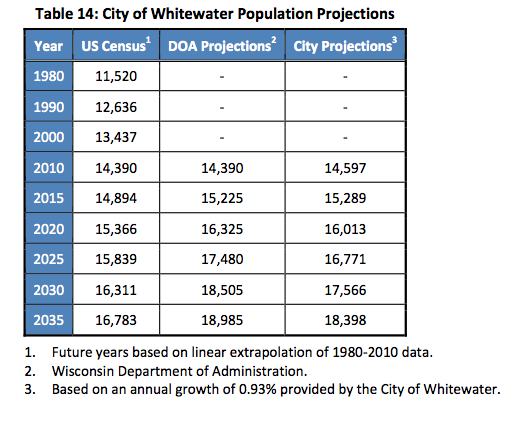 Post 23 in a series. When Green Turns Brown is an examination of a small town’s digester-energy project, in which Whitewater, Wisconsin would import other cities’ waste, claiming that the result would be both profitable and green.
Post 23 in a series. When Green Turns Brown is an examination of a small town’s digester-energy project, in which Whitewater, Wisconsin would import other cities’ waste, claiming that the result would be both profitable and green.
Engineering firm Donohue prepared several memoranda about their proposal for Whitewater’s wastewater facility. In posts 19 and 20 in this series – The Scope of Donohue’s Work (Part 1), The Scope of Donohue’s Work (Part 2) – one sees that Donohue describes a strategic direction for Whitewater (selling water, importing waste) that neither City Manager Clapper nor Wastewater Superintendent Reel has mentioned as a primary goal in any of their published presentations. (The public presentations do not match the published strategic direction in fundamental ways. The gap suggests either a lack of candor or a lack of focus.)
Today, I’ll look at a part of Donohue’s Technical Memorandum 2, Flows, Loadings, and Existing Conditions (embedded in full, below). A critical portion of that memorandum – a work for which in total Whitewater would pay Donohue over a million in fees – raises questions about Donohue’s understanding of the city’s population and demographics, among other topics.
(Every question in this series has a unique number, assigned chronologically based on when it was asked. All the questions from When Green Turns Brown can be found in the Question Bin. Today’s questions begin with No. 164.)
In Section 4.1 (Growth Projections), Donohue writes that “[d]ifferent projections were developed based on information from the US Census, Wisconsin Department of Administration (DOA), and the City of Whitewater.” I’ve placed the table below.

164. Why these three estimates – not why three estimates, but why these three?
165. Of the three, aren’t two of these sources (Wisconsin Department of Administration, City of Whitewater) expressly political bodies in the way that the third (U.S. Census Bureau) is not?
166. Wouldn’t a political body have an incentive to contend for population increases as evidence of growth, vitality, etc.?
167. Of the City of Whitewater’s case, Donohue writes that
The population of the City of Whitewater has steadily increased for several decades. However, the City is anticipating significant growth through the year 2035. The census population for the City was 14,390 in 2010. The City?led growth study predicted a growth rate of 0.93 percent annually for 2008 to 2013, and the City has adopted this growth rate for long?range planning purposes. Based on this data, the year 2035 (design year) population is projected to be 18,398.
Why would the City-led growth study assume that a bounceback-from-recession, pre-university-cuts level of growth from ’08-’13 would continue identically each year for the next 22 years? What does it reliably mean, if anything, that Whitewater takes a number from the recent past and simply ‘adopts’ it as a standard for the next two decades?
168. Does the City of Whitewater analysis take into account university cuts’ impact on the economy and growth of our city since 2013? If not, why not?
169. If the City of Whitewater projections do take into account university cuts’ impact on the economy and growth of our city since 2013, and still the city estimates significant growth, then does City Manager Clapper conclude that the cuts will have no impact on growth?
170. Aren’t a recent study and findings from Sarah Kemp of the Applied Population Laboratory at the University of Wisconsin-Madison on enrollment and demographics in the Whitewater Unified School District evidence that, in the city and surrounding area, growth that produces enrollment gains will be tepid? Why would one conclude in favor of the City of Whitewater’s rosy population estimates (simply adopting an increase for the next two decades) over actual evidence of decline (in this case, of school enrollment, and therefore families bringing children into area schools)?
171. Why does Donohue not use population protections from the Southeastern Wisconsin Regional Planning Commission (SEWRPC)? They make no mention of the SEWPRC or its work in population projection and analysis. (The Southeastern Wisconsin Regional Planning Commission (SEWRPC) “is the official metropolitan planning organization (MPO) and regional planning commission (RPC) for the seven county southeastern Wisconsin area.” Walworth County is part of the organization, an organization founded in 1960. Their data are for Walworth County. )
172. If Donohue had used the respected Southeastern Wisconsin Regional Planning Commission estimates, wouldn’t they have found 15,838 as the 2035 population estimate (SEWRPC Regional Land Use Plan (Intermediate Growth Scenario) or 15,273 (Trend Based)? (See, Comprehensive Plan for Walworth County: 2035.)
173. Of the five available population projections, hasn’t Donohue adopted one that’s ten-percent higher than the U.S. Census (simply projected by Donohue linearly) and sixteen-percent higher than our area’s own regional planning authority’s estimates for our principal county?
174. Was Donohue even aware of the Southeastern Wisconsin Regional Planning Commission work? If so, shouldn’t they explain the decision to omit it? If not, why would Whitewater’s city administration , itself, ignore that work, and leave Donohue’s ignorance of it uncorrected?
[gview file=”http://www.whitewater-wi.gov/images/stories/public_works/wastewater/Donohue_Technical_Memo_2_-_Flows_Loadings_and_Existing_Conditions.pdf”]
Donohue Technical Memo 2, Flows, Loadings, and Existing Conditions, http://www.whitewater-wi.gov/images/stories/public_works/wastewater/Donohue_Technical_Memo_2_-_Flows_Loadings_and_Existing_Conditions.pdf.
Next Time: “Estimates of Future Flows and Loadings,” showing again how this project is, fundamentally and not incidentally, about the importation of other cities’ unwanted waste into Whitewater.
WHEN GREEN TURNS BROWN: Mondays @ 10 AM, here on FREE WHITEWATER.